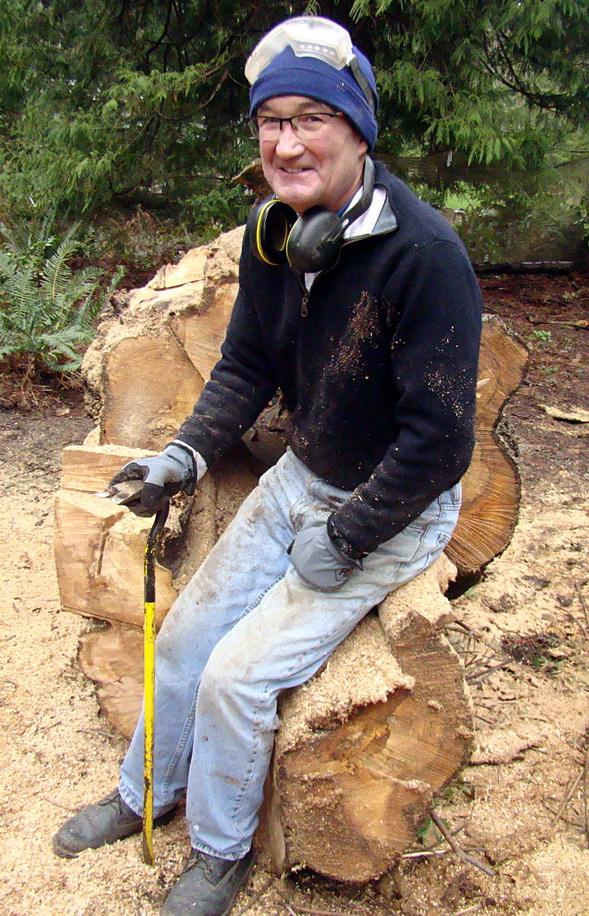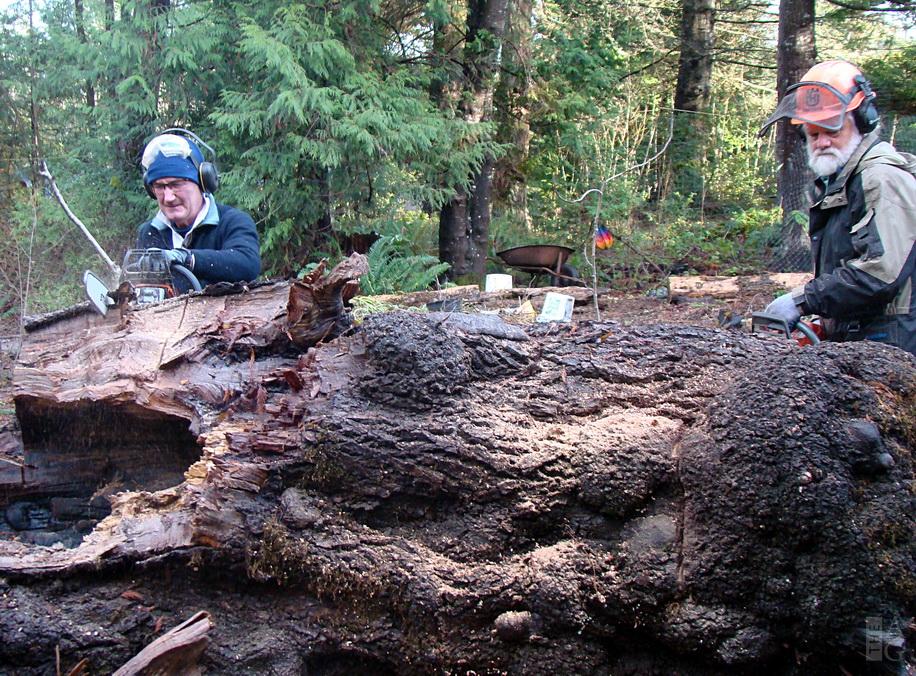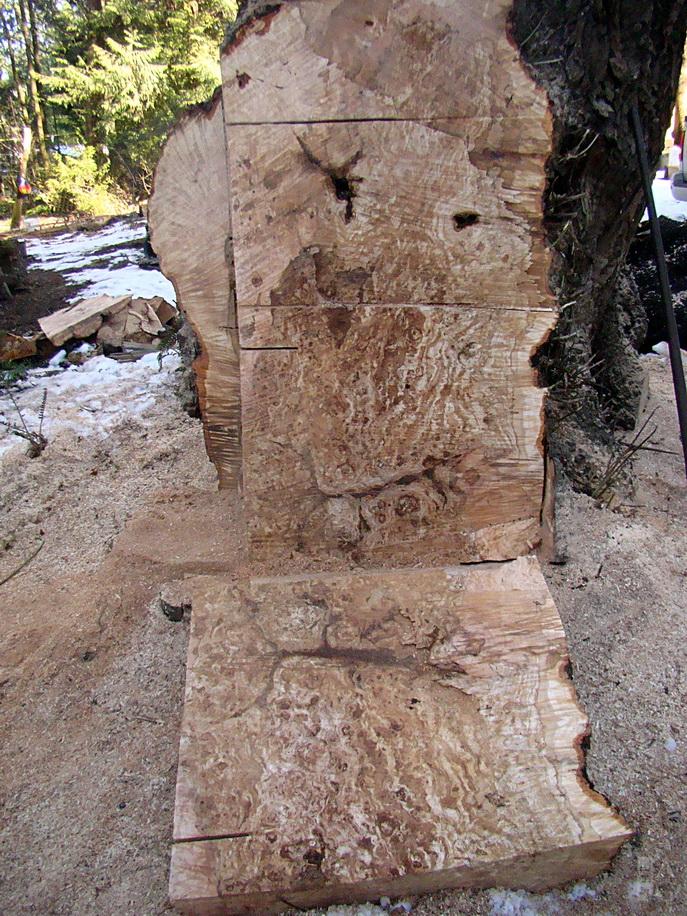Bruce Edmundson’s elegant wood sculptures begin as bumps on a log, aka burls, so when he learns I’ve got a felled, super bumpy big leaf maple tree at my place, he’s happy to take a look.
He’s brought along his friend Kent Mjolness, and they eagerly circle the massive, hollow trunk sections. There are plenty of visible burls, which are actually rounded growths formed when a tree is under stress from an injury, virus or fungus. I tell them I considered turning the maple into firewood. I detect some shudders.
Burl wood has unusual texture, colour and figure (or appearance). Birdseye, resembling tiny swirling bird’s eyes distributed through the grain, is a much prized figure of wood. Spalting, a dark line at the edge of any rot in the wood, lends definition and is also sought after. Turns out my old maple has all the right stuff.
“It’s an abundance of wealth!” declares Edmundson. In fact, through his art, Edmundson will give the old maple a second life. I can almost hear it whispering “hallelujah” as Edmundson runs a gloved hand over the bark.
He and Mjolness get out the chainsaws and sawdust flies as they cut off burls and slabs. Edmundson chooses burls that are deep enough to accommodate sculpting.

Edmundson, who lives in Victoria, and Mjolness, a Salt Spring resident, are old friends. They met in the 1980s while tree planting in the Clearwater area of B.C., where Edmundson also did his first carvings. Mjolness has continued to work in silviculture through his Caliburn Silviculture company.
Prior to retirement, Edmundson worked in many B.C. government jobs — in the Ministry of Forests, the Office of the Ombudsperson and as chief liquor inspector responsible for public safety in all B.C. licensed premises. He also has a Master of Fine Arts in Creative Writing and has published a book of short stories called Two Voices.
Now, he’s creating fine art from wood. Finding and rescuing burls is only step one in the process. He transports the wood to his studio, where it has to dry. “I use a moisture meter to monitor the progress,” he explains.
When it’s ready for carving, Edmundson secures the wood, usually with a carver’s vice with a mounting plate that can move on a multi-directional axis. Even if he can hold a smaller piece in his hand while using a rotary tool, he doesn’t.
“A fingerless carver carves few sculptures,” he says.
The technical side of wood carving involves cutting, shaping, and sanding with power tools. Wood carving videos abound on the internet, if you want to see the variety of tools and techniques employed by carvers.
Edmundson initially cuts out his basic shape with a chainsaw or reciprocating saw. Then he removes bulk wood with carbide tungsten carving discs attached to an angle grinder. Further definition is accomplished with a mini grinder with smaller discs, and a die grinder with carbide shaping burrs. He sands the piece with a contour random orbital sander and various disc sander attachments.
But how art emerges from wood is a little less straightforward.
“I sketch ideas on paper. I often start with iconic images, for example, a moon, a heart, a cross, a star,” says Edmundson. He keeps a notebook of ideas, and rips images out of magazines for inspiration.

But when it’s time to carve, he lets things happen. The wood speaks, and he listens to the wood.
“I usually draw on the wood with a chalk or crayon. At this stage I often abandon the icon that started things and draw onto the piece what the piece will allow.”
“Burls,” he adds, “aren’t particularly conducive to having predetermined images imposed on them due to their particular shape, which is basically ovoid with one flat surface and numerous irregularities. I like the irregularities and want to incorporate their interesting colours, textures and shapes into the piece.”
Throughout, Edmundson says, “What I am trying to do is to display a human-enhanced vision of the intrinsic beauty of the natural wood. Elegance is a word I often find myself coming back to when I am shaping curves and making decisions about what stays and what goes.”
His piece titled Heart, finished with tung oil and polished with beeswax, is an example of that elegance. But it had humble beginnings.
A response to a burl-seeking ad he placed on Kijiji led him to a former turkey farm with rows of timber harvested by the landowner many years before.
“The wood was small and there were no burls. He took me to another shed where he was refurbishing a beautiful old rowboat. He pulled a slab of something from the rafters, about three feet by three feet, three inches thick with a big scar in the middle. It was the right colour to be a maple burl slab. He sold it to me for $10.” A heart evolved as Edmundson tried to come up with something to avoid the scar in the middle.
Another sculpture, titled Ponds, was originally a large, thin burl cut by someone else. At the time, Edmundson was experimenting with bowls.
“I played with numerous circular shapes trying to fit them on in various sizes. The breakthrough was seeing that incomplete circles were what might make it more interesting. The next step was trusting that instinct and carving it out with that as part of the plan.”
A piece called Flame is what he calls “a carving exercise.”
“It came from an old burl, very dry with lots of spalting, which is those black lines delineating lines of mould in the wood. There is a fine line between being too rotten and having that lovely spalt, which adds so much to the piece. This piece was from a thin narrow burl and I challenged myself to create movement.”

In return for my gift of wood, Edmundson presents me with a carving of an unusual maple bowl. It’s open to the world on one side, while the other side is laced with ovoid holes. The wood is silky smooth, figured with birds eye and spalting. I don’t ask him for the story of my bowl. I’ll let the wood speak, and I’ll listen.
Story by Pat Burkette, Photos by Pat Burkette and courtesy Bruce Edmundson, originally published in the July 2017 issue of Aqua-Gulf Islands Living Magazine
